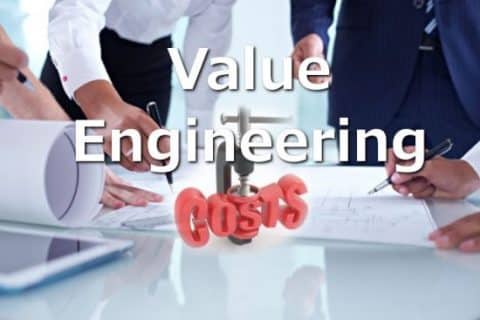You’ve collaborated with your design team to create your ideal structure. You’re getting your employees, residents, customers, or church pumped about the new structure. You solicit bids from a group of general contractors, eager to turn this beautiful design into a reality.
However, the bids are much greater than you imagined.
Is it time to mercilessly “value engineer” your project to reduce costs? No, not always. When we hear the term “value engineering,” we immediately think of a procedure that minimizes the cost of a project by eliminating portions or lowering the grade of materials used. However, it is not always the case with value engineering. Let’s see the definition of value engineering and all it entails in construction projects.
Value Engineering Definition
Value engineering refers to the systematic method of improving the What is value engineering used for? that a project produces. From this definition, we can say that value engineering (VE) in construction is a way that your project team can use to increase the value of your project by assessing the function of each item or piece and its associated cost. Your team can give proposals for other building methods, designs, or materials that increase the value of the project by analyzing the cost/benefit ratio.
It is critical to understand that increasing the value of your project does not imply decreasing expenditures. It entails optimizing the project’s elements based on an examination of all criteria such as cost, upkeep, wear-and-tear, aesthetic value, and so on.
To give truly beneficial value to engineering, your construction and design team must first comprehend the project as a whole, as well as your vision and goals for the project. Each project is unique, as is each client’s notion of value.
Establishing “Value” or your Project
A good value is defined as something that has a positive cost-benefit ratio. While costs can be simple to quantify – how much they cost upfront – there is a little more to them. To truly grasp the significance, you must delve deeper. How long can the materials be expected to last? What kind of upkeep will they require? Will they be more efficient and less expensive to run? The best place to begin is by asking yourself what the most important part(s) of the project are, and what you want the project to accomplish.
Once you’ve established them, share them with your value engineering team, and they’ll respond with a list of suggestions that respect your goals while also improving your project to give the most possible value while staying within your budget. This approach focuses on adding value to your specific project rather than broad cost-cutting strategies that may not be the best fit for your needs or goals. A good value engineering team will consider everything and find you the best quality options at the lowest possible cost.
Keep the following three main criteria in mind when evaluating these suggestions: cost reduction, added quality, and life cycle/maintenance.
#1. Cost Reduction
Many value engineering techniques are motivated by a desire to reduce costs. Your value engineering team will bring to your project proposals for less expensive materials or systems for your consideration. Whether it’s locating a less expensive equivalent fixture or replacing a superfluous feature, these tips can add value to your project.
However, without the following requirements, value engineering would just be referred to as cost-cutting. Added quality ensures that cost cuts do not reduce the project’s value.
#2. Quality
This must be considered before making any conclusions about your value engineering solutions. Quality can refer to a variety of things. The standard of the environment you’re creating. The standard of the products that comprise that environment. The caliber of the team you’ve assembled to create that environment.
While some equipment or design aspects may be more expensive, they may be justified by the quality that they provide. Higher-priced components and elements may enable you to demand a higher fee for your services. They may improve the productivity or satisfaction of those who will use the place. A high-quality product may have greater total value than a low-cost product.
#3. Maintenance/Life Cycle
Similarly to quality, it is critical to evaluate the long-term consequences of these value engineering initiatives. While low-cost flooring may appear to be the most cost-effective option at first, if you have to replace it twice as frequently as higher-cost flooring, it may end up costing you more money in the long term.
However, if saving that extra money upfront is the difference between getting your idea off the ground and it stalling in design, then making that decision may be the best option.
When Should you perform Value Engineering?
A construction project is divided into three stages: project planning, design, and construction. As the owner, you have the option of requesting value engineering services at any moment during the construction process. However, the benefits and drawbacks of making adjustments differ depending on the stage.
Value Engineering During Project Planning
In most circumstances, the optimal moment to value engineer is during the planning stage of your project. The cost of implementing these adjustments will be the lowest, and the impact on the project’s timeline will be the smallest.
At this point, your value engineering team will inspect the facility and collaborate with you to develop your project vision and objectives. With this information, they will be able to provide you with alternatives that will work for your project. They will then incorporate them into the project plan in a seamless manner.
While this requires more upfront planning, it can spare you from costly change orders that can cause your project’s timetable to slip later on.
Value Engineering During the Design Phase
Value engineering occurs during the design phase of most typical projects. The owner collaborates with an architect to create construction documents, which are subsequently utilized by contractors to create estimates. When those estimates are found to be excessively high, the project team goes back to the drawing board (literally) and begins looking for ways to save you money.
However, it is important to emphasize that value engineering should not be limited to cutting building costs. The value engineering team must consider long-term costs as well as the overall value of the project to provide recommendations that are in line with the owner’s goals.
One disadvantage of performing the majority of your value engineering during the design phase is that you may incur redesign expenditures.
Value Engineering During the Construction Phase
Just because boots are on the ground and construction is underway does not mean that your project team should cease scrutinizing the project. Through value engineering change orders, value engineering can continue as work is put in place with ideas from contractors.
However, because the building has already begun, revisions to the designs can be costly and may lead the project to go behind schedule. All value engineering proposals made during this construction phase must be evaluated seriously to comprehend the entire impact of the change on the project.
That is why it is critical to work with a construction company that is dedicated to doing the right thing and being good stewards of your resources.
Value Engineering Procedures
Value engineering can be divided into the following stages:
#1. Information
The information phase entails acquiring project information and refining project goals. Data is collected and analyzed, and the results are utilized to finalize project priorities and areas for improvement.
Potential concerns are subdivided into constituent components, which are factors that must be handled. This phase also includes determining the ways that the team will use to assess the project’s progress.
#2. Function Evaluation
The function analysis step entails determining the project’s functions and identifying them with a verb/noun combination for each element under consideration. The function is defined as the set of goals to be achieved by executing an element or a set of elements.
Each of the indicated functions is examined to see whether it may be improved or if a new function is necessary. “disinfect water” is an example of a function.
The function should be as general as feasible to allow for numerous possibilities that accomplish the project’s function. Each recognized function is assigned a cost.
#3. Innovative
The creative phase comes after the function analysis phase and entails experimenting with different approaches to execute the function(s) determined during the function analysis phase. This permits team members to come up with alternatives to existing systems or processes.
Brainstorming forces people to be creative and allows team members to speculate on all conceivable solutions to the challenges presented, as well as alternate functions. The team must create a list of potential solutions to the function defined by the verb/noun pair.
#4. Assessment
The advantages and demerits of each of the recommended solutions and alternatives from the creative phase are listed in the value engineering assessment phase. Each advantage and disadvantage should be described in broad strokes by the team.
When the disadvantages outweigh the benefits, the alternative is abandoned in favor of more solid alternatives. The team groups and ranks the possibilities using a weighted matrix analysis, and the best choices are chosen for consideration in the following phase.
#5. Development
During the development phase, each optimal alternative is thoroughly examined to see how it may be implemented and the associated costs. Examining each alternative may necessitate the creation of sketches, cost estimates, and another technical study.
Team members create a project implementation plan that outlines the steps to be taken in carrying out the final recommendations.
#6. Presentation
The team meets with management and other stakeholders to give their final report during the value engineering presentation phase. The team must convey its results to decision-makers using reports, flow charts, and other presentation materials to persuade them that the final concepts from the development phase should be implemented.
The concepts should be detailed in full, including costs, benefits, and potential obstacles. The final report serves as a record of the team’s achievements during the investigation. It also serve as a summary of the team’s deliberations and results. It might also serve as a resource for the organization in future ventures.
#7. Put into action
The project’s implementation begins after management approves the team’s recommendations. If management or other decision-makers request adjustments, these should be integrated into the implementation strategy before the implementation begins.
The team should guarantee that the primary goal of increasing value is met when implementing the project. The real cost savings of the project should be calculated depending on the recommendations’ execution.
How can Value Engineering be incorporated into a company’s culture and business strategy?
Incorporating Value Engineering into a company’s culture and business strategy is essential for continuous improvement and long-term success. One way to do this is by making Value Engineering a standard part of the project management process and continuously training employees on its principles and techniques. Additionally, incorporating VE principles into a company’s decision-making process can help ensure that cost-saving and value-adding opportunities are being pursued throughout the organization.
What is the future of Value Engineering?
The future of Value Engineering is bright as its principles and techniques continue to be adopted and incorporated into a growing number of industries and project types. As the importance of cost-effectiveness and value-addition continues to be emphasized, the demand for Value Engineers and VE processes is likely to grow. Additionally, advancements in technology and automation may bring new opportunities for the application of VE principles and tools.
How does Value Engineering ensure customer satisfaction?
By incorporating the customer’s requirements and expectations into the Value Engineering process, VE helps ensure that the end result will meet or exceed their needs. Through this focus on the customer, VE helps drive value-addition and improve customer satisfaction.
How does Value Engineering impact a project’s budget?
By finding cost-saving and value-adding opportunities, Value Engineering can help reduce a project’s overall budget. Additionally, VE can help ensure that the project’s budget is being allocated to the areas that will provide the most value, maximizing its return on investment.
Can Value Engineering be applied to any type of project?
Yes, Value Engineering can be applied to any type of project, regardless of size, scope, or industry. Its principles and techniques are designed to be flexible and adaptable to any situation, making it a versatile tool for project managers and teams.
Value Engineering FAQs
What is difference between value engineering and value analysis?
Value engineering is strongly related to target costing since it is cost avoidance or cost reduction prior to production, while value analysis is cost avoidance or cost reduction of an existing product; both take the same approach (details below), which is a comprehensive audit of the product.
What are the disadvantages of value engineering?
One significant disadvantage of value engineering is that it is sometimes misunderstood as a cost-cutting strategy after the fact, without taking into account life cycle costs during the process.
What is value engineering used for?
Value engineering is used to solve problems, identify and eliminate unwanted costs and improve function and quality. The set of disciplined steps in the value engineering process is meant to optimize initial and long-term investment, seeking the best possible value for the lowest cost.
- Construction Project Management: Beginner’s Guide to Efficient Management
- Product Lifecycle Management PLM: Detailed Guide to the PLM System
- Project Cost Management: How to Create a Cost Management Plan
- PROJECT FINANCE: Simple Guide to Kick start any Project(+ best picks)
- Construction Management at Risk: Best Practices, Contracts, Pros & Cons







1 comment
It was really informative when you explained that value engineering is a systematic method that is used to improve the value of a product. I would imagine that businesses would want to improve the value of their products on a yearly basis. It seems like these businesses would want to find a professional that can assist with this form of engineering.